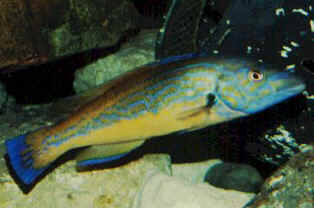Labrus mixtus - Cuckoo Wrasse
Phylum: Chordata - Class: Actinopterygii - Order: Percifromes - Family: Labridae

The female cuckoo wrasse is orange, with three dark marks on its back towards the tail - quite unlike the remarkably colourful male, illustrated here. At spawning time, the male cuckoo wrasse develops a white patch on the top of its head. The front rays of the dorsal fin are spiny.
These are slow-growing fish, and males can live for more than twenty years; they attain a length of typically 30cm when fully grown. The Welsh record stands at 1lb 8oz (approx. 0.7kg) and was caught off St Annes Head, on the Pembrokeshire coast of West Wales.
Wrasse are found in rocky areas and are plentiful around the shores of West Wales and the Gower Peninsula, where they feed by day and retire to rock clefts during the night. They feed on molluscs and crustaceans, using the crushing pharyngeal teeth in their throat to break up their food. Never put your fingers in the mouth of a wrasse, therefore.
A wide range of baits will take wrasse. These include worms, crab, mussels and limpets. Because they feed over rough ground, a 'rotten bottom' type of rig is recommended where the weights can break away if they get snagged. Old spark plugs or large nuts and bolts are traditionally used for this purpose.
Other wrasse species you may encounter when fishing off the rocky shores of Wales include the ballan wrasse, the corkwing wrasse and the relatively rare goldsinny.
Excited at the prospect of flyfishing? So are we, and we're pretty sure you would find the Winding River Mystery trilogy of action-packed thrillers gripping reading too. Dead Drift, Dead Cert, and Dead End are Pat O'Reilly's latest river-and-flyfishing based novels, and now they are available in ebook format. Full details on our website here...
Buy each book for just £4.96 on Amazon...
Please Help Us: If you have found this information interesting and useful, please consider helping to keep First Nature online by making a small donation towards the web hosting and internet costs.
Any donations over and above the essential running costs will help support the conservation work of Plantlife, the Rivers Trust and charitable botanic gardens - as do author royalties and publisher proceeds from books by Pat and Sue.
